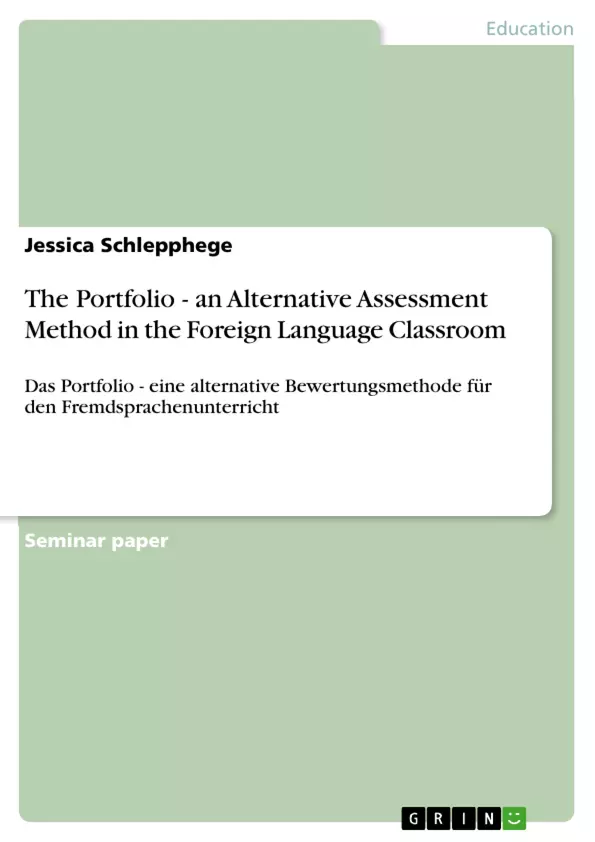“Important decisions should not
rest on simple test scores”
Bailey 1998, 204
If important decisions should not rely on simple test scores, what else can we as language teachers do to underpin our impression about a student’s language ability? HEATON (1979, 7-8) suggests in his text ‘Writing English Language Tests’ to take into account a number of other factors, preferably from alternative assessment. One very popular alternative assessment method is the portfolio.
In this paper I will discuss the portfolio as a possible assessment method and its implementation in the foreign language classroom. Beginning with a brief introduction to the concept of alternative assessment and its positive features in contrast to traditional assessment methods, the portfolio shall then be introduced in detail. A summary of the advantages and disadvantages of using portfolios as an assessment tool are content of the next chapters, followed by an examination of the technical quality of portfolios. Finally I will have a closer look at marking strategies and tie up the paper with the conclusion.
Inhaltsverzeichnis (Table of Contents)
- INTRODUCTION.
- BRIEF INTRODUCTION TO ALTERNATIVE ASSESSMENT.
- POSITIVE FEATURES OF ALTERNATIVE ASSESSMENT METHODS
- THE PORTFOLIO METHOD
- Definition Portfolio
- Different Portfolio Types
- Criteria For A Good Use Of Portfolios.
- ADVANTAGES OF USING PORTFOLIOS AS AN ASSESSMENT METHOD
- DISADVANTAGES OF USING PORTFOLIOS AS AN ASSESSMENT METHOD
- TECHNICAL QUALITY OF PORTFOLIO ASSESSMENT.
- Reliability
- Validity...
- Conclusion........
- STRATEGIES TO MARK PORTFOLIOS
- Using Assessment Criteria Scales..
- Integrating Other Persons In The Marking Process.
- CONCLUSION.
Zielsetzung und Themenschwerpunkte (Objectives and Key Themes)
The paper explores the portfolio as a viable assessment method within the foreign language classroom. It aims to present the portfolio as an alternative to traditional testing, highlighting its benefits and drawbacks. The paper also delves into the technical aspects of portfolio assessment, focusing on its reliability and validity.
- Alternative assessment methods
- Advantages and disadvantages of portfolio assessment
- Technical quality of portfolio assessment
- Strategies for marking portfolios
- Implementation of portfolios in the foreign language classroom
Zusammenfassung der Kapitel (Chapter Summaries)
The introductory chapter sets the stage by arguing that important decisions should not rely solely on test scores. It introduces the concept of alternative assessment and positions the portfolio as a popular method. Subsequent chapters delve into the positive features of alternative assessment methods, contrasting them with traditional approaches. The portfolio method is then defined and discussed in detail, exploring various types of portfolios and criteria for effective implementation.
The paper further examines the advantages and disadvantages of using portfolios as an assessment tool for students, teachers, and other stakeholders. It then explores the technical aspects of portfolio assessment, discussing reliability and validity concerns. Finally, the paper delves into strategies for marking portfolios, including the use of assessment criteria scales and the integration of other individuals in the marking process.
Schlüsselwörter (Keywords)
Alternative assessment, portfolio assessment, foreign language learning, assessment criteria, reliability, validity, marking strategies, student evaluation, teacher evaluation.
- Quote paper
- Jessica Schlepphege (Author), 2009, The Portfolio - an Alternative Assessment Method in the Foreign Language Classroom, Munich, GRIN Verlag, https://www.grin.com/document/141017



